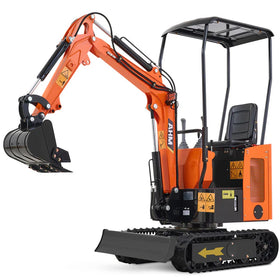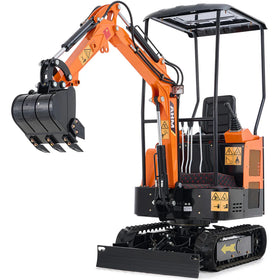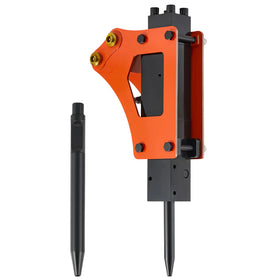One wrong move while loading your skid steer on a trailer can wreck your equipment, damage the trailer, or cause accidents that cost thousands in repairs. Most people learn how to load a skid steer on a trailer the hard way after their first close call with uneven weight distribution or faulty tie-downs.
Getting a 1,700 - 8,000-pound machine onto a trailer safely requires knowing proper positioning, correct tie-down techniques, and putting some thought into weight distribution. Experts recommend tongue weight should be 9-15% of the gross trailer weight for bumper-pull trailers and 20-25% for gooseneck setups. Get those numbers wrong and you're looking at trailer sway, jackknifing, or worse

How to Load a Skid Steer on a Trailer
For loading your skid steer on a trailer safely, it’s important to follow a systematic process that prevents accidents and ensures proper weight distribution. Skip any of these steps and you're asking for trouble.
Step 1: Choose the Right Trailer
Your trailer needs to be capable of handling the weight without overloading. Buying a trailer with about 25% more payload capacity than your base skid steer’s weight is recommended, giving you enough room for attachments and other materials.
Trailer Gross Vehicle Weight Rating requirements:
- Mini skid steers (1,700-2,500 lbs): 8,000-10,000 lb GVWR trailer minimum
- Medium skid steers (5,000-7,000 lbs): 14,000-16,000 lb GVWR trailer
- Large skid steers (8,000-10,000 lbs): 18,000-20,000 lb GVWR trailer
Step 2: Position the Trailer Correctly
Park the trailer on flat, level ground before you attempt to load it. Working on uneven surfaces will increase the risk of tipping.
- Find a flat, accessible surface and position the trailer
- Ensure the trailer is level front to back and side to side
- Align the trailer with a straight approach path for the skid steer
- Deploy ramps fully and verify that they are resting firmly on the ground
- Double-check for stability before starting to load
Step 3: Prepare the Skid Steer for Loading
Lower the bucket and any attachments to the ground before loading. This lowers the center of gravity and makes the machine more stable during transport.
- Lower the bucket to the ground position
- Retract lift arms completely
- Check whether the parking brake functions properly
- Clear any debris from tracks or wheels
Step 4: Align and Drive Onto the Trailer
Position your skid steer directly in front of the trailer ramps with the machine centered. The tires or tracks need to line up precisely for smooth access up the ramps.
- Center skid steer with trailer ramps.
- Drive forward steadily up ramps at a consistent speed
- Keep the machine lined up with the center of the trailer
- Avoid sudden movements or speed changes
- Maintain low bucket position throughout climb
Step 5: Position the Skid Steer on the Trailer Properly
Where to position a skid steer on a trailer directly affects tongue weight and trailer stability. Position the machine over or slightly forward of the trailer axles for proper weight distribution.
- Place the skid steer centered over the trailer axles
- Slightly forward of the axles is better than behind them
- Aim for 60% of the weight toward the front of the trailer
- Watch the truck rear end sag 3-4 inches when properly loaded
- Tongue weight should be 10-15% of gross trailer weight (bumper-pull)
- Tongue weight should be 20-25% for gooseneck trailers
Step 6: Secure the Skid Steer with Tie-Downs
Wondering how to secure a skid steer on a trailer? Use heavy-duty chains or ratchet straps rated for your skid steer's weight. Department of Transportation regulations specify that each tie-down assembly must be rated for at least 50% of the cargo weight.
- Use 5/16-inch chains minimum for machines under 5,000 lbs, and 3/8-inch chains for machines 5,000-10,000 lbs.
- Attach chains to designated tie-down points on the skid steer frame
- Avoid contact with hydraulic lines or moving parts
- Cross-strap diagonally for added stability
- Use ratchet binders rather than lever types for controlled tensioning
- Double-check all connections before transport
- Verify the parking brake is engaged

Tips for Transporting a Mini Skid Steer on a Trailer
Follow proper transport techniques to prevent damage and ensure safe travel on the highway with your loaded trailer.
Pre-transport inspection:
- Walk around and verify all chains are tight and secure
- Check that the skid steer cannot move or shift on the trailer
- Inspect trailer lights and brake connections
- Verify trailer tire pressure is correct for the load
- Test whether the parking brake holds the machine in place
During transport:
- Stop after the first 15-20 miles to recheck tie-downs, as chains can loosen as equipment settles during initial travel
- Maintain steady speeds and avoid sudden braking
- Watch for trailer sway indicating weight distribution problems
- Plan the route considering height clearances with a loaded trailer
Unloading safely:
- Select a level, stable ground for unloading
- Remove tie-downs in reverse order of installation
- Start the skid steer and verify controls operate properly
- Back down ramps slowly with bucket low, keeping the machine centered
Transporting a Skid Steer vs Transporting an Excavator on a Trailer
Loading a mini excavator and skid steer on a trailer requires different techniques due to differences in weight distribution and dimensions. If you’re hauling both machines on the same trailer, position the heavier machine (usually the excavator) forward of the lighter machine to maintain proper tongue weight.
|
Factor |
Mini Skid Steer |
Mini Excavator |
|
Typical Weight |
1,700-2,500 lbs (compact models) |
4,000-9,000 lbs (average) |
|
Weight Distribution |
Most weight is in the rear (engine area) |
More evenly distributed |
|
Loading Direction |
Backward (engine-first) preferred |
Either direction works |
|
Height Concerns |
Lower profile, fewer clearance issues |
Must fold the boom and lower arm |
|
Width |
45-72 inches typical |
35-60 inches typical |
|
Ramp Stability |
Wheels can slip on wet ramps |
Tracks provide better traction |
|
Trailer Requirements |
8,000-10,000 lb GVWR for compact models |
14,000-16,000 lb GVWR minimum |
|
Positioning on Trailer |
Over or slightly forward of the axles |
Centered over axles or slightly forward |
|
Combined Loading |
Load as the lighter machine, position at the rear |
Load as the heavier machine, position forward |
Affordable Mini Skid Steer from AHM
The AHM SS-38 mini skid steer at 1,733 pounds operating weight makes trailer transport straightforward compared to heavier machines. At 45.3 inches wide and 82.1 inches long, this compact machine fits easily on standard equipment trailers without the headaches of oversized loads.
- 1,733 lb operating weight fits 8,000-10,000 lb GVWR trailers easily
- 45.3-inch width fits within the wheel wells of most flatbed trailers
- 82.1-inch length allows room for attachments on 14-16 foot trailers
- Fits on smaller trailers pulled by 1/2-ton and 3/4-ton trucks
- 827 lb lift capacity handles attachments without overloading the trailer
- 30-degree climbing angle navigates steeper trailer ramps
- Enhanced hydraulics support various attachments during transport
- 5.4 cu. ft. bucket provides good material capacity for the machine size
 The Bottom Line
The Bottom Line
To load a skid steer on a trailer safely, it requires proper trailer selection, correct positioning over the axles, and secure tie-downs rated for your machine's weight. Aim for 10-15% tongue weight on bumper-pull trailers by positioning the machine over or slightly forward of the axles.
The AHM SS-38 at 1,733 pounds operating weight simplifies trailer transport compared to heavier skid steers. The compact size fits standard equipment trailers easily, while the light weight works with
trailers pulled by 3/4-ton trucks. Position it properly, secure it with appropriate chains, and you're ready for safe transport to your next job site.







